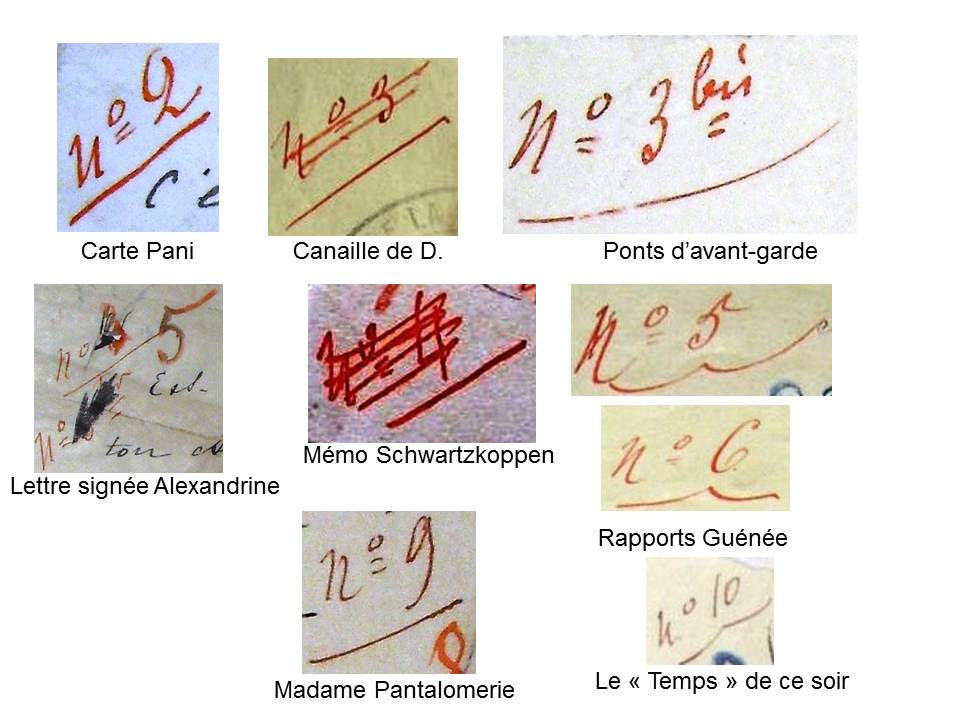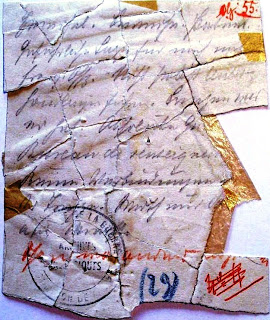The Secret File

The 374 symbols of the secret file kept at the Historical Defense Service in Vincennes bear at least eight different numberings, more or less superimposed on each other.
One of these numberings, produced in red pen, is remarkable: it is only present on a dozen pieces of the file, all prior to the second half of 1894 and also forming a digital suite. Always in red pen and in the form "n ° X", always worn on the original document, it is found on four of the five documents considered to be part of the secret file in the canonical version. It therefore seems to designate the original secret file presented to the judges of the Alfred Dreyfus trial in December 1894.
Of the pieces cited in 1894, only the “Davignon Letter” does not bear this numbering, but, damaged, it could have lost it. On the other hand, “Ce canaille de D.” is rated “n ° 3” and the flag “n ° 4”. The two false reports by French agent Guénée are numbered "n ° 5" and "n ° 6". That these forgeries, manufactured after 1896 but supposed to date from 1894 and to have belonged to the original file presented to the War Council, were numbered in red pen proves that at the time of their manufacture, this numbering constituted a pledge of authenticity.
The red feather corpus also contains five letters sent by the Italian military attaché in Paris, Alessandro Panizzardi, to his German colleague, Maximilian von Schwartzkoppen, revealing that the two men collaborated as spies, but that they were also lovers - at least two of these letters were, moreover, explicitly erotic. Finally, a note from Panizzardi to his ambassador, dated November 2, 1894, reveals his perplexity when the newspapers announced the arrest of Dreyfus. This corpus of ten pieces, larger than the canonical reconstruction of the original secret file, includes pieces never mentioned in historiography - in particular certain letters from Panizzardi to Schwartzkoppen.
The corpus numbered in red pen therefore constitutes a coherent whole, centered on the couple of German and Italian military attachés, and their activities as spies and lovers.
Exhibit N ° 3: Canaille de D.
My dear friend
I very much regret not having seen you before my departure. Besides, I'll be back in a week.
So attached 12 nice blueprints that this scoundrel from D. gave me for you. I told her that you have no plans to resume relationships.
He claims that there was a misunderstanding and that he will do everything possible to satisfy you.
He says he was stubborn and you don't hold it against him. I replied that he was crazy and that I did not believe that you would want to resume relations with him.
Do what you want!
Goodbye, I'm in a big hurry.
Alexandrine
Do not stuff too much !!!
This letter, a draft in pencil from the German military attaché Schwartzkoppen, is central. It is unanimously accepted by witnesses at the start of the case, among Dreyfusards as well as among Antidreyfusards. Everyone who read it remembered it years after the fact. Certainly, this missive was therefore part of the file.
This handwritten letter is an exchange between the two military attachés Maximilian von Schwartzkoppen, German, and Alessandro Panizzardi, Italian, written by the former as he recognized in his memoirs. It was for a long time erroneously attributed to the latter - yet it is hard to see what interest the German master plans would have had for the German.
Exhibit 4: Memento

Doubt - proofs - Service letter - Dangerous situation for me with a French Officer. - not personally conduct negotiations. - bring what he has. - absolute ………. Office information. - no relation .... Troop corps. - Importance
only …………… leaving the ministry. Already somewhere else …… ..
Although not all witnesses cited this document, it is quite likely that this draft handwritten note from Colonel von Schwartzkoppen was part of the secret file.
It’s a key piece, because it’s most certainly the notes that the German military attaché took on the day of the traitor’s first visit to the German Embassy, Commander Walsin Esterhazy. These notes seem to follow the thread of an interview that the two men probably had. Schwartzkoppen did not refute this point in his memoirs.
By tortuous reasoning, the soldiers of the Statistics Section claimed that this note accused Dreyfus. In the absence of an adversarial debate, no one was able to dispute this claim, especially as the German text was interpreted appropriately.
When Colonel Picquart, on the Esterhazy trail from the spring of 1896, became aware of the secret file kept at the Statistics Section at the end of the summer, he judged that the text applied perfectly to the suspect commander. Intense debates took place at the Court of Cassation and at the Rennes trial over the attribution of this text. The convincing exegesis of Colonel Picquart at the Rennes trial in 1899, then at the Court of Cassation in 1904, won the support of historiography.
